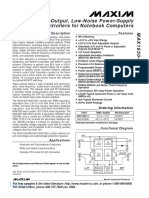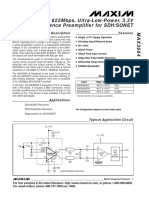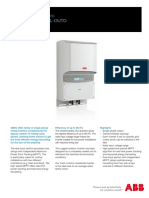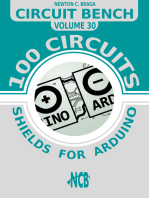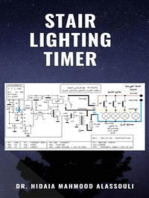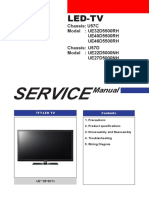Max603 Max604
Max603 Max604
Uploaded by
Anderson GonçalvesCopyright:
Available Formats
Max603 Max604
Max603 Max604
Uploaded by
Anderson GonçalvesOriginal Description:
Original Title
Copyright
Available Formats
Share this document
Did you find this document useful?
Is this content inappropriate?
Copyright:
Available Formats
Max603 Max604
Max603 Max604
Uploaded by
Anderson GonçalvesCopyright:
Available Formats
MAX603/MAX604 5V/3.
3V or Adjustable, Low-Dropout,
Low IQ, 500mA Linear Regulators
General Description Features
The MAX603/MAX604 low-dropout, low quiescent current, ●● 500mA Output Current, with Foldback Current
linear regulators supply 5V, 3.3V, or an adjustable output Limiting
for currents up to 500mA. They are available in a 1.8W SO ●● High-Power (1.8W) 8-Pin SO Package
package. Typical dropouts are 320mV at 5V and 500mA,
or 240mV at 3.3V and 200mA. Quiescent currents are ●● Dual Mode™ Operation: Fixed or Adjustable Output
15μA typ and 35μA max. Shutdown turns off all circuitry from 1.25V to 11V
and puts the regulator in a 2μA off mode. A unique protection ●● Large Input Range (2.7V to 11.5V)
scheme limits reverse currents when the input voltage falls ●● Internal 500mA P-Channel Pass Transistor
below the output. Other features include foldback current
●● 15μA Typical Quiescent Current
limiting and thermal overload protection.
●● 2μA (Max) Shutdown Mode
The output is preset at 3.3V for the MAX604 and 5V
for the MAX603. In addition, both devices employ Dual ●● Thermal Overload Protection
Mode™ operation, allowing user-adjustable outputs from ●● Reverse-Current Protection
1.25V to 11V using external resistors. The input voltage
supply range is 2.7V to 11.5V. Applications
The MAX603/MAX604 feature a 500mA P-channel ●● 5V and 3.3V Regulators
MOSFET pass transistor. This transistor allows the devices ●● 1.25V to 11V Adjustable Regulators
to draw less than 35μA over temperature, independent ●● Battery-Powered Devices
of the output current. The supply current remains low ●● Pagers and Cellular Phones
because the P-channel MOSFET pass transistor draws ●● Portable Instruments
no base currents (unlike the PNP transistors of conventional ●● Solar-Powered Instruments
bipolar linear regulators). Also, when the input-to-output
voltage differential becomes small, the internal P-channel
MOSFET does not suffer from excessive base current
Ordering Information appears at end of data sheet.
losses that occur with saturated PNP transistors.
Typical Operating Circuit Pin Configuration
TOP VIEW
OUT OUTPUT
IN
VOLTAGE
MAX603
MAX604 IN 1 8 OUT
OFF COUT GND 2 MAX603 7 GND
BATTERY CIN MAX604
10µF GND
10µF GND 3 6
GND SET
OFF 4 5 SET
DIP/SO
Dual Mode is a trademark of Maxim Integrated Products.
19-0269; Rev 1; 4/17
MAX603/MAX604 5V/3.3V or Adjustable, Low-Dropout,
Low IQ, 500mA Linear Regulators
Absolute Maximum Ratings
Supply Voltage (IN or OUT to GND)......................-0.3V to +12V Operating Temperature Ranges
Output Short-Circuit Duration.............................................. 1 min MAX60_C_A........................................................0°C to +70°C
Continuous Output Current...............................................600mA MAX60_E_A.................................................... -40°C to +85°C
SET, OFF Input Voltages........................... -0.3V to the greater of MAX60_MJA.................................................. -55°C to +125°C
(IN + 0.3V) or (OUT + 0.3V) Junction Temperature.......................................................+150°C
Continuous Power Dissipation (TA = +70°C) Storage Temperature Range............................. -65°C to +160°C
Plastic DIP (derate 9.09mW/°C above +70°C).............727mW Lead Temperature (soldering, 10sec).............................. +300°C
SO (derate 23.6mW/°C above +70°C).............................1.8W
CERDIP (derate 8.00mW/°C above +70°C).................640mW
Stresses beyond those listed under “Absolute Maximum Ratings” may cause permanent damage to the device. These are stress ratings only, and functional operation of the device at these
or any other conditions beyond those indicated in the operational sections of the specifications is not implied. Exposure to absolute maximum rating conditions for extended periods may affect
device reliability.
Electrical Characteristics
(VIN = 6V (MAX603) or 4.3V (MAX604), CIN = COUT = 10μF, OFF = VIN, SET = GND, TJ = TMIN to TMAX, unless otherwise noted.
Typical values are at TJ = +25°C.) (Note 1)
PARAMETER SYMBOL CONDITIONS MIN TYP MAX UNITS
MAX60_C 2.7 11.5
Input Voltage VIN SET = OUT, RL = 1kΩ MAX60_E 2.9 11.5 V
MAX60_M 3.0 11.5
IOUT = 20μA to 500mA,
MAX603 4.75 5.00 5.25
6.0V < VIN < 11.5V
Output Voltage (Note 2) VOUT V
IOUT = 20μA to 300mA,
MAX604 3.15 3.30 3.45
4.3V < VIN < 11.5V
MAX603C/E 60 100
IOUT = 1mA to 500mA
Load Regulation ∆VLDR MAX603M 150 mV
IOUT = 1mA to 300mA MAX604 30 100
Line Regulation ∆VLNR (VOUT + 0.5V) ≤ VIN ≤ 11.5V, IOUT = 25mA 7 40 mV
IOUT = 200mA 130 220
MAX603
IOUT = 500mA 320 550
Dropout Voltage (Note 3) ∆VDO mV
IOUT = 200mA 240 410
MAX604
IOUT = 400mA 480 820
MAX60_C/E 15 35
Quiescent Current IQ 3.0V ≤ VIN ≤ 11.5V, SET = OUT μA
MAX60_M 40
MAX60_C 0.01 2
OFF ≤ 0.4V, RL = 1kΩ,
OFF Quiescent Current IQ OFF MAX60_E 10 µA
(VOUT + 1V) ≤ VIN ≤ 11.5V
MAX60_M 20
MAX60_C 2
Minimum Load Current IOUT MIN VIN = 11.5V, SET = OUT MAX60_E 6 µA
MAX60_M 20
Foldback Current Limit VOUT < 0.8V 350
ILIM mA
(Note 4) VOUT > 0.8V and VIN - VOUT > 0.7V 1200
Thermal Shutdown Temperature TSD 160 °C
Thermal Shutdown Hysteresis ∆TSD 10 °C
www.maximintegrated.com Maxim Integrated │ 2
MAX603/MAX604 5V/3.3V or Adjustable, Low-Dropout,
Low IQ, 500mA Linear Regulators
Electrical Characteristics (continued)
(VIN = 6V (MAX603) or 4.3V (MAX604), CIN = COUT = 10μF, OFF = VIN, SET = GND, TJ = TMIN to TMAX, unless otherwise noted.
Typical values are at TJ = +25°C.) (Note 1)
PARAMETER SYMBOL CONDITIONS MIN TYP MAX UNITS
Reverse-Current Protection VOUT = 4.5V MAX603 6 20
∆VRTH mV
Threshold (Note 5) VOUT = 3.0V MAX604 6 20
MAX60_C 0.01 10
VIN = 0V, VOUT = 4.5V
Reverse Leakage Current IRVL (MAX603) VOUT = 3.0V MAX60_E 20 µA
(MAX604)
MAX60_M 100
Start-Up Overshoot VOSH RL = 1kΩ, COUT = 10μF, OFF rise time ≤ 1μs 2 %VOUT
VIN = 9V, RL = 18Ω, VOFF switched from
Time Required to Exit Shutdown tSTART 200 µs
0V to VIN, time from 0% to 95% of VOUT
For internal feedback 80 30
Dual-Mode SET Threshold VSET TH mV
For external feedback 150 80
SET Reference Voltage VSET SET = OUT, RL = 1kΩ 1.16 1.20 1.24 V
SET Input Leakage Current ISET VSET = 1.5V or 0V ±0.01 ±10 nA
MAX60_C 0.01 2
VIN = 11.5V, VOUT = 2V,
OUT Leakage Current IOUT LKG MAX60_E 6 μA
SET = OUT
MAX60_M 20
VIL OFF Off 0.4
On, SET = OUT, VIN = 4V 2.0
OFF Threshold Voltage
VIH OFF On, SET = OUT, VIN = 6V 3.0 V
On, SET = OUT, VIN = 11.5V 4.0
OFF Input Leakage Current IOFF VOFF = VIN or GND ±0.01 ±10 nA
10Hz to 10kHz, SET = OUT, RL = 1kΩ,
Output Noise (Note 6) en 250 μVRMS
COUT = 10μF
Note 1: Electrical specifications are measured by pulse testing and are guaranteed for a junction temperature (TJ) equal to the
operating temperature range. C and E grade parts may be operated up to a TJ of +125°. Expect performance similar to M
grade specifications. For TJ between +125°C and +150°C, the output voltage may drift more.
Note 2: (VIN - VOUT) is limited to keep the product (IOUT x (VIN - VOUT)) from exceeding the package power dissipation limits.
Note 3: Dropout Voltage is (VIN - VOUT) when VOUT falls to 100mV below its nominal value at VIN = VOUT + 2V. For example, the
MAX603 is tested by measuring the VOUT at VIN = 7V, then VIN is lowered until VOUT falls 100mV below the measured
value. The difference (VIN - VOUT) is then measured and defined as ∆VDO.
Note 4: Foldback Current Limit was characterized by pulse testing to remain below the maximum junction temperature.
Note 5: The Reverse-Current Protection Threshold is the output/input differential voltage (VOUT - VIN) at which reverse-current
protection switchover occurs and the pass transistor is turned off.
Note 6: Noise is tested using a bandpass amplifier with two poles at 10Hz and two poles at 10kHz.
www.maximintegrated.com Maxim Integrated │ 3
MAX603/MAX604 5V/3.3V or Adjustable, Low-Dropout,
Low IQ, 500mA Linear Regulators
Typical Operating Characteristics
(VIN = 7V for MAX603, VIN = 5.3V for MAX604, OFF = VIN, SET = GND, CIN = COUT = 10μF, RL = 1kΩ, TJ = +25°C, unless otherwise noted.)
OUTPUT VOLTAGE AND
OUTPUT VOLTAGE vs. LOAD CURRENT QUIESCENT CURRENT vs. LOAD CURRENT QUIESCENT CURRENT vs. SUPPLY VOLTAGE
1.01 30 6 24
MAX603/4-TOC-01
MAX603/4-TOC-02
MAX1603/4 TOC-03
MAX603, VOUT = 5V 22
1.00 25
NORMALIZED OUTPUT VOLTAGE
5
QUIESCENT CURRENT (µA) 20
MAX603, VIN = 12V, VOUT = 10V
QUIESCENT CURRENT (µA)
OUTPUT VOLTAGE (V)
0.99 20 4 18
MAX604, VOUT = 3.3V I Q, MA X603
MAX603, VIN = 7V, VOUT = 5V 16
0.98 15 3
04
MAX604, VIN = 5.3V, VOUT = 3.3V IQ, MAX6 14
0.97 10 2 12
VOUT = 3.3V, 5V, 10V
NORMALIZED TO 10
0.96 5 1
OUTPUT VOLTAGE UPWARD CURVE IS
8
AT 1mA THERMAL EFFECT
0.95 0 0 6
0.1 1 10 100 700 0.1 1 10 100 700 2 3 4 5 6 7 8 9 10 11 12
LOAD CURRENT (mA) LOAD CURRENT (mA) SUPPLY VOLTAGE (V)
OUTPUT VOLTAGE vs. QUIESCENT CURRENT vs.
TEMPERATURE TEMPERATURE DROPOUT VOLTAGE vs. LOAD CURRENT
104 25 0.9
MAX603/4-TOC-04
MAX603/4-TOC-05
MAX603/4-TOC-06
MAX604
0.8
NORMALIZED OUTPUT VOLTAGE (%)
103 VOUT = 3.3V
MAX603
20
QUIESCENT CURRENT (µA)
102 0.7
DROPOUT VOLTAGE (V)
0.6
101 MAX604
15
0.5 MAX603
100 VOUT = 5V
0.4 .2Ω
99 10 =1 .65Ω
) =0 = 0.4
Ω
0.3 ( ON (O N) N)
R DS R DS R DS(O
98 0.2
5
97 0.1 MAX603, VOUT = 10V,
SET EXTERNALLY
96 0 0
-55 -35 -15 5 25 45 65 85 105 125 -55 -35 -15 5 25 45 65 85 105 125 0 100 200 300 400 500 600 700
TEMPERATURE (°C) TEMPERATURE (°C) LOAD CURRENT (mA)
10Hz TO 10kHz OUTPUT NOISE LINE-TRANSIENT RESPONSE
A
OUTPUT NOISE (1mV/div)
MAX603
MAX603 VOUT = 5V
VOUT = 5V tR = 10µs, tF = 70µs
10ms/div 2ms/div
A: VIN = 8V (HIGH), VIN = 7V (LOW)
B: OUTPUT VOLTAGE (50mV/div)
www.maximintegrated.com Maxim Integrated │ 4
MAX603/MAX604 5V/3.3V or Adjustable, Low-Dropout,
Low IQ, 500mA Linear Regulators
Typical Operating Characteristics (continued)
(VIN = 7V for MAX603, VIN = 5.3V for MAX604, OFF = VIN, SET = GND, CIN = COUT = 10μF, RL = 1kΩ, TJ = +25°C, unless otherwise noted.)
OVERSHOOT AND TIME
LOAD-TRANSIENT RESPONSE EXITING SHUTDOWN MODE
B
5V
A
A
B
MAX603 0V
VOUT = 5V
2ms/div 500µs/div
A: OFF PIN VOLTAGE (1V/div)
A: OUTPUT VOLTAGE (100mV/div)
RISE TIME = 13µs
B: IOUT = 500mA (HIGH), IOUT = 5mA (LOW)
B: MAX603 OUTPUT VOLTAGE (1V/div)
DELAY = 4.936ms, OVERSHOOT = 1%, RISE TIME = 55µs
Pin Description
PIN NAME DESCRIPTION
1 IN Regulator Input. Supply voltage can range from 2.7V to 11.5V.
Ground. These pins function as heatsinks, only in the SOIC package. All GND pins must be soldered to the
2, 3, 6, 7 GND
circuit board for proper power dissipation. Connect to large copper pads or planes to channel heat from the IC.
4 OFF Shutdown, active low. Switch logic levels in less than 1µs with the high level above the OFF threshold.
Feedback for Setting the Output Voltage. Connect to GND to set the output voltage to the preselected 3.3V
5 SET
or 5V. Connect to an external resistor network for adjustable output operation.
8 OUT Regulator Output. Fixed or adjustable from 1.25V to 11.0V. Sources up to 500mA for input voltages above 4V.
1 MAX603 8
IN MAX604 OUT VOUT
2 7
GND GND
VIN 3 6 R1
GND GND
CIN COUT RL
10µF 4 5 10µF
OFF SET
R2
Figure 1. Test Circuit
www.maximintegrated.com Maxim Integrated │ 5
MAX603/MAX604 5V/3.3V or Adjustable, Low-Dropout,
Low IQ, 500mA Linear Regulators
IN
SHUTDOWN
MOSFET DRIVER
WITH FOLDBACK REVERSE
CURRENT LIMIT P CURRENT
ERROR AMP PROTECTION
OFF SHUTDOWN
LOGIC
OUT
SET
R1
1.20V
REFERENCE DUAL-MODE
THERMAL COMPARATOR
SENSOR 80mV R2
MAX603
GND
MAX604
Figure 2. Functional Diagram
Detailed Description The output voltage is fed back through either an internal
The MAX603/MAX604 are low-dropout, low-quiescent- resistor voltage divider connected to the OUT pin, or
current linear regulators designed primarily for battery- an external resistor network connected to the SET pin.
powered applications. They supply an adjustable 1.25V The dual-mode comparator examines the SET voltage
to 11V output or a preselected 5V (MAX603) or 3.3V and selects the feedback path used. If SET is below
(MAX604) output for load currents up to P-channel. As 80mV, internal feedback is used and the output voltage is
illustrated in Figure 2, they consist of a 1.20V reference, regulated to 5V for the MAX603 or 3.3V for the MAX604.
error amplifier, MOSFET driver, P-channel pass transis- Additional blocks include a foldback current limiter, reverse
tor, dual-mode comparator, and internal feedback voltage current protection, thermal sensor, and shutdown logic.
divider. Internal P-Channel Pass Transistor
The 1.20V bandgap reference is connected to the error The MAX603/MAX604 feature a 500mA P-channel
amplifier’s inverting input. The error amplifier compares MOSFET pass transistor. This provides several advan-
this reference with the selected feedback voltage and tages over similar designs using PNP pass transistors,
amplifies the difference. The MOSFET driver reads the including longer battery life.
error signal and applies the appropriate drive to the
The P-channel MOSFET requires no base drive, which
P-channel pass transistor. If the feedback voltage is lower
reduces quiescent current considerably. PNP based regu-
than the reference, the pass transistor gate is pulled
lators waste considerable amounts of current in dropout
lower, allowing more current to pass and increasing the
when the pass transistor saturates. They also use high
output voltage. If the feedback voltage is too high, the
base-drive currents under large loads. The MAX603/
pass transistor gate is pulled up, allowing less current to
MAX604 do not suffer from these problems and consume
pass to the output.
only 15μA of quiescent current under light and heavy
loads, as well as in dropout.
www.maximintegrated.com Maxim Integrated │ 6
MAX603/MAX604 5V/3.3V or Adjustable, Low-Dropout,
Low IQ, 500mA Linear Regulators
Output Voltage Selection
The MAX603/MAX604 feature dual-mode operation. In
OUTPUT
preset voltage mode, the output of the MAX603 is set VOLTAGE
IN OUT
to 5V and the output of the MAX604 is set to 3.3V using
internal, trimmed feedback resistors. Select this mode by MAX603
MAX604 R1
connecting SET to ground.
OFF SET COUT
In adjustable mode, an output between 1.25V and 11V is CIN RL
BATTERY 0.1µF to 10µF
selected using two external resistors connected as a volt- 10µF GND
R2
age divider to SET (Figure 3). The output voltage is set by
the following equation:
R1
VOUT VSET 1 +
=
R2
where VSET = 1.20V. To simplify resistor selection: Figure 3. Adjustable Output Using External Feedback Resistors
V
=R1 R2 OUT − 1 for output voltages above 0.8V and VIN - VOUT > 0.7V.
V
SET For VIN - VOUT < 0.7V (dropout operation), there is no
Since the input bias current at SET is nominally zero, current limit. If the output voltage drops below 0.8V, imply-
large resistance values can be used for R1 and R2 to ing a short-circuit condition, the output current is limited
minimize power consumption without losing accuracy. Up to 350mA. The output can be shorted to ground for one
to 1.5MΩ is acceptable for R2. Since the VSET tolerance minute without damaging the device if the package can
is less than ±40mV, the output can be set using fixed dissipate VIN x 350mA without exceeding TJ = +150°C.
resistors instead of trim pots. Thermal Overload Protection
In preset voltage mode, impedances between SET and Thermal overload protection limits total power dissipation
ground should be less than 10kΩ. Otherwise, spurious in the MAX603/MAX604. When the junction temperature
conditions could cause the voltage at SET to exceed the exceeds TJ = +160°C, the thermal sensor sends a signal
80mV dual-mode threshold. to the shutdown logic, turning off the pass transistor and
allowing the IC to cool. The thermal sensor will turn the
Shutdown
pass transistor on again after the IC’s junction tempera-
A low input on the OFF pin shuts down the MAX603/ ture cools by 10°C, resulting in a pulsed output during
MAX604. In the off mode, the pass transistor, control cir- thermal overload conditions.
cuit, reference, and all biases are turned off, reducing the
supply current below 2μA. OFF should be connected to IN Thermal overload protection is designed to protect the
for normal operation. MAX603/MAX604 in the event of fault conditions. For
continual operation, the absolute maximum junction tem-
Use a fast comparator, Schmitt trigger, or CMOS or TTL perature rating of TJ = +150°C should not be exceeded.
logic to drive the OFF pin in and out of shutdown. Rise
times should be shorter than 1μs. Do not use slow RC cir- Operating Region and Power Dissipation
cuits, leave OFF open, or allow the input to linger between Maximum power dissipation of the MAX603/MAX604
thresholds; these measures will prevent the output from depends on the thermal resistance of the case and circuit
jumping to the positive supply rail in response to an inde- board, the temperature difference between the die junc-
terminate input state. tion and ambient air, and the rate of air flow. The power
Since the OFF threshold varies with input supply voltage dissipation across the device is P = IOUT (VIN - VOUT).
(see Electrical Characteristics), do not derive the drive The resulting maximum power dissipation is:
voltage from 3.3V logic. With VIN at 11.5V, the high OFF
logic level needs to be above 4V. (TJ − T A )
PMAX =
(θ + θ )
Foldback Current Limiting JB BA
The MAX603/MAX604 also include a foldback current
limiter. It monitors and controls the pass transistor’s gate where (TJ - TA) is the temperature difference between the
voltage, estimating the output current and limiting it to 1.2A MAX603/MAX604 die junction and the surrounding air, θJB
www.maximintegrated.com Maxim Integrated │ 7
MAX603/MAX604 5V/3.3V or Adjustable, Low-Dropout,
Low IQ, 500mA Linear Regulators
POWER DISSIPATION vs. MAXIMUM OUTPUT CURRENT vs. SUPPLY VOLTAGE
GROUND PAD AREA
1.8 MAX603
700
MAX603/4 FIG 4
MAX603/4-FIG-04A
MAXIMUM CONTINUOUS CURRENT LIMIT
1.7
MAXIMUM OUTPUT CURRENT (mA)
600 HIGH-POWER
TYPICAL DROPOUT VOLTAGE LIMIT
MAXIMUM SUPPLY VOLTAGE LIMIT
POWER DISSIPATION (W)
1.6 SOIC
500
1.5
400
1.4
MAX603, VOUT = 5V
1.3 8-PIN SO PACKAGE 300
PAPER EPOXY BOARD PLASTIC DIP
1.2 SINGLE SIDED 200
1oz. COPPER OPERATING
1.1 TJ = +125°C 100 REGION AT
TA = +25°C STILL AIR TA = +25°C CERAMIC DIP
1.0 TJ = +125°C
0
0.2 1 10 20 (in2)
4 5 6 7 8 9 10 11 12 13
1.3 6.5 65 130 (cm2)
SUPPLY VOLTAGE (V)
COPPER GROUND PAD AREA
MAX604
700
Figure 4. Typical Maximum Power Dissipation vs. Ground Pad
MAX603/4-FIG-04B
MAXIMUM CONTINUOUS CURRENT LIMIT
Size.
MAXIMUM OUTPUT CURRENT (mA)
600
HIGH-POWER SOIC
TYPICAL DROPOUT VOLTAGE LIMIT
MAXIMUM SUPPLY VOLTAGE LIMIT
500
(or θJC) is the thermal resistance of the package chosen,
and θBA is the thermal resistance through the printed cir- 400
cuit board, copper traces and other materials to the sur- 300
rounding air. The 8-pin SOIC package for the MAX603/
PLASTIC DIP
MAX604 features a special lead frame with a lower thermal 200
resistance and higher allowable power dissipation. The OPERATING
100 REGION AT
thermal resistance of this package is θJB = 42°C/W, com- TA = +25°C
TJ = +125°C CERAMIC DIP
pared with θJB = 110°C/W for an 8-pin plastic DIP package 0
and θJB = 125°C/W for an 8-pin ceramic DIP package. 2 3 4 5 6 7 8 9 10 11 12 13
SUPPLY VOLTAGE (V)
The GND pins of the MAX603/MAX604 SOIC package
perform the dual function of providing an electrical con-
nection to ground and channeling heat away. Connect all Figure 5. Power Operating Regions: Maximum Output Current
vs. Differential Supply Voltage
GND pins to ground using a large pad or ground plane.
Where this is impossible, place a copper plane on an
adjacent layer. The pad should exceed the dimensions
in Figure 4. in Figure 5. Maximum power dissipation depends on
Figure 4 assumes the IC is an 8-pin SOIC package, is sol- packaging, board layout, temperature, and air flow. The
dered directly to the pad, has a +125°C maximum junction maximum output current is:
temperature and a +25°C ambient air temperature, and
PMAX × (TJ − T A )
has no other heat sources. Use larger pad sizes for other I OUT(max) =
packages, lower junction temperatures, higher ambient (VIN − VOUT ) × 100°C
temperatures, or conditions where the IC is not soldered
where PMAX is derived from Figure 4.
directly to the heat-sinking ground pad.
The MAX603/MAX604 can regulate currents up to 500mA Reverse-Current Protection
and operate with input voltages up to 11.5V, but not simul- The MAX603/MAX604 has a unique protection scheme
taneously. High output currents can only be sustained that limits reverse currents when the input voltage falls
when input-output differential voltages are low, as shown below the output. It monitors the voltages on IN and OUT
www.maximintegrated.com Maxim Integrated │ 8
MAX603/MAX604 5V/3.3V or Adjustable, Low-Dropout,
Low IQ, 500mA Linear Regulators
Applications Information
OUT OUTPUT
IN
VOLTAGE Figure 6 illustrates the typical application for the MAX603/
MAX603 MAX604.
MAX604
BATTERY CIN OFF COUT Capacitor Selection and
10µF Regulator Stability
GND SET Normally, use 0.1μF to 10μF capacitors on the input and
10μF on the output of the MAX603/MAX604. The larger
input capacitor values provide better supply-noise rejec-
tion and line-transient response. Improve load-transient
response, stability, and power-supply rejection by using
Figure 6. 3.3V or 5V Linear-Regulator Application
large output capacitors. For stable operation over the full
temperature range and with load currents up to 500mA,
10μF is recommended. Using capacitors smaller than
3.3μF can result in oscillation.
POWER-SUPPLY REJECTION RATIO
vs. FREQUENCY Noise
90
The MAX603/MAX604 exhibit 3mVP-P to 4mVP-P of
MAX603/4-FIG-06
80 noise during normal operation. This is negligible in most
IOUT = 1mA
70 applications. When using the MAX603/MAX604 in appli-
60 cations that include analog-to-digital converters of greater
than 12 bits, consider the ADC’s power-supply rejection
PSRR (dB)
50
specifications. Refer to the output noise plot in the Typical
40
Operating Characteristics.
30
VIN = 1Vp-p IOUT = 100mA PSRR and Operation from Sources
20 FOR f < 400kHz Other than Batteries
10 CIN = 0µF
COUT = 10µF The MAX603/MAX604 are designed to deliver low dropout
0 voltages and low quiescent currents in battery-powered
100 101 102 103 104 105 106
systems. Achieving these objectives requires trading off
FREQUENCY (Hz)
power-supply noise rejection and swift response to sup-
ply variations and load transients. Power-supply rejection
Figure 7. Power-Supply Rejection Ratio vs. Ripple Frequency is 80dB at low frequencies and rolls off above 10Hz. As
the frequency increases above 10kHz, the output capaci-
and switches the IC’s substrate and power bus to the tor is the major contributor to the rejection of power-
more positive of the two. The control circuitry can then supply noise (Figure 7). Do not use power supplies with
remain functioning and turn the pass transistor off, limit- ripple above 100kHz, especially when the ripple exceeds
ing reverse currents back through the device. This feature 100mVP-P. When operating from sources other than
allows a backup regulator or battery pack to maintain batteries, improved supply-noise rejection and transient
VOUT when the supply at IN fails. response can be achieved by increasing the values of the
input and output capacitors, and through passive filtering
Reverse-current protection activates when the voltage on
techniques. The Typical Operating Characteristics show the
IN falls 6mV (20mV maximum) below the voltage on OUT.
MAX603/MAX604 supply and load-transient responses.
Before this happens, currents as high as several milliam-
peres can flow back through the device. After switchover, Transient Considerations
typical reverse currents are limited to 0.01μA for as long The Typical Operating Characteristics show the MAX603/
as the condition exists. MAX604 load-transient response. Two components of the
output response can be observed on the load-transient
graphs—a DC shift from the output impedance due to the
different load currents, and the transient response. Typical
transients for step changes in the load current from 5mA
to 500mA are 0.2V. Increasing the output capacitor’s value
attenuates transient spikes.
www.maximintegrated.com Maxim Integrated │ 9
MAX603/MAX604 5V/3.3V or Adjustable, Low-Dropout,
Low IQ, 500mA Linear Regulators
Input-Output (Dropout) Voltage Package Information
A regulator’s minimum input-output voltage differential, or For the latest package outline information and land patterns (foot-
dropout voltage, determines the lowest usable supply volt- prints), go to www.maximintegrated.com/packages. Note that
age. In battery-powered systems, this will determine the a “+”, “#”, or “-” in the package code indicates RoHS status only.
useful end-of-life battery voltage. Because the MAX603/ Package drawings may show a different suffix character, but the
MAX604 use a P-channel MOSFET pass transistor, their drawing pertains to the package regardless of RoHS status.
dropout voltage is a function of rDS(ON) multiplied by the
load current (see Electrical Characteristics). PACKAGE PACKAGE OUTLINE LAND PATTERN
TYPE CODE NO. NO.
Quickly stepping up the input voltage from the dropout
voltage can result in overshoot. This occurs when the 8 PDIP P8+3 21-0043 —
pass transistor is fully on at dropout and the IC is not 8 SOIC S8-7F 21-0041 90-0096
given time to respond to the supply voltage change. 8 CDIP J8-3 — –
Prevent this by slowing the input voltage rise time.
Chip Topography Ordering Information
PART TEMP. RANGE PIN-PACKAGE
IN OUT
MAX603CPA 0°C to +70°C 8 Plastic DIP
MAX603CSA 0°C to +70°C 8 SO
MAX603C/D 0°C to +70°C Dice*
MAX603EPA -40°C to +85°C 8 Plastic DIP
MAX603ESA -40°C to +85°C 8 SO
MAX603MSA/PR+T -55°C to +125°C 8 SO
MAX604CPA 0°C to +70°C 8 Plastic DIP
0.100" MAX604CSA 0°C to +70°C 8 SO
(2.54mm)
MAX604C/D 0°C to +70°C Dice*
MAX604EPA -40°C to +85°C 8 Plastic DIP
MAX604ESA -40°C to +85°C 8 SO
* Dice are tested at TA = +25°C, DC parameters only.
** Contact factory for availability.
OFF GND SET
0.104"
(2.64mm)
TRANSISTOR COUNT: 111
NO DIRECT SUBSTRATE CONNECTION. THE N-SUBSTRATE
IS INTERNALLY SWITCHED BETWEEN THE MORE POSITIVE
OF IN OR OUT.
www.maximintegrated.com Maxim Integrated │ 10
MAX603/MAX604 5V/3.3V or Adjustable, Low-Dropout,
Low IQ, 500mA Linear Regulators
Revision History
REVISION REVISION PAGES
DESCRIPTION
NUMBER DATE CHANGED
0 9/94 Initial Release —
1 4/17 Updated Ordering Information table 10
For pricing, delivery, and ordering information, please contact Maxim Direct at 1-888-629-4642, or visit Maxim Integrated’s website at www.maximintegrated.com.
Maxim Integrated cannot assume responsibility for use of any circuitry other than circuitry entirely embodied in a Maxim Integrated product. No circuit patent licenses
are implied. Maxim Integrated reserves the right to change the circuitry and specifications without notice at any time. The parametric values (min and max limits)
shown in the Electrical Characteristics table are guaranteed. Other parametric values quoted in this data sheet are provided for guidance.
Maxim Integrated and the Maxim Integrated logo are trademarks of Maxim Integrated Products, Inc. © 2017 Maxim Integrated Products, Inc. │ 11
You might also like
- Low-Cost, Micropower, Low-Dropout, High-Output-Current, SOT23 Voltage ReferencesDocument14 pagesLow-Cost, Micropower, Low-Dropout, High-Output-Current, SOT23 Voltage ReferencesjjoaquimmartinsNo ratings yet
- Max6070 Max6071 PDFDocument23 pagesMax6070 Max6071 PDFXan OVNo ratings yet
- Max1818 1515441Document10 pagesMax1818 1515441Rafael BrunoNo ratings yet
- Max889 PDFDocument8 pagesMax889 PDFameer_jaburNo ratings yet
- Max2680/Max2681/ Max2682 400Mhz To 2.5Ghz, Low-Noise, Sige Downconverter MixersDocument12 pagesMax2680/Max2681/ Max2682 400Mhz To 2.5Ghz, Low-Noise, Sige Downconverter MixersDusan PejicNo ratings yet
- Monolithic Voltage-Controlled Oscillators: General Description FeaturesDocument6 pagesMonolithic Voltage-Controlled Oscillators: General Description FeaturesGerard PabloNo ratings yet
- MAX6126- Bộ Kết Hợp Điều Khiển Áp Suất Cài ĐặtDocument28 pagesMAX6126- Bộ Kết Hợp Điều Khiển Áp Suất Cài ĐặtTan BuiNo ratings yet
- 1.8V To 28V Input, PWM Step-Up Controllers in MAX: General Description FeaturesDocument18 pages1.8V To 28V Input, PWM Step-Up Controllers in MAX: General Description FeaturesStoica VictorNo ratings yet
- Precision, Micropower, Low-Dropout, High-Output-Current, SO-8 Voltage ReferencesDocument17 pagesPrecision, Micropower, Low-Dropout, High-Output-Current, SO-8 Voltage ReferencesIsraelNo ratings yet
- Max6966 Max6967Document29 pagesMax6966 Max6967208020No ratings yet
- MAX890LDocument8 pagesMAX890LEdson HenriqueNo ratings yet
- 5V/3.3V/3V/Adjustable, High-Efficiency, Low I, Step-Down DC-DC ConvertersDocument12 pages5V/3.3V/3V/Adjustable, High-Efficiency, Low I, Step-Down DC-DC ConvertersJorge Centeno RamosNo ratings yet
- Unisonic Technologies Co., LTD: Earth Leakage Current DetectorDocument9 pagesUnisonic Technologies Co., LTD: Earth Leakage Current Detectortharishr@gmail.comNo ratings yet
- Multi-Output, Low-Noise Power-Supply Controllers For Notebook ComputersDocument28 pagesMulti-Output, Low-Noise Power-Supply Controllers For Notebook ComputersAleksNo ratings yet
- 100% Duty Cycle, Low-Noise, Step-Down, PWM DC-DC ConverterDocument12 pages100% Duty Cycle, Low-Noise, Step-Down, PWM DC-DC ConvertershivabglNo ratings yet
- MST5333BTEDocument10 pagesMST5333BTEtemp512No ratings yet
- MST5350B MilestoneSemiconductorDocument10 pagesMST5350B MilestoneSemiconductorJR RegisNo ratings yet
- Gatemode-Gm7333 C2833582Document7 pagesGatemode-Gm7333 C2833582Xeeshan KhanNo ratings yet
- Max4063 PDFDocument14 pagesMax4063 PDFUday KrishnaNo ratings yet
- Max4063 PDFDocument14 pagesMax4063 PDFUday KrishnaNo ratings yet
- (600 Volts Peak) : Semiconductor Technical DataDocument6 pages(600 Volts Peak) : Semiconductor Technical DataDario Amaris MarquezNo ratings yet
- AD694Document12 pagesAD694Océane SavaryNo ratings yet
- MAX1044/ICL7660 Switched-Capacitor Voltage Converters: General Description FeaturesDocument15 pagesMAX1044/ICL7660 Switched-Capacitor Voltage Converters: General Description FeaturesJuan CarlosNo ratings yet
- MAX668/MAX669 1.8V To 28V Input, PWM Step-Up: General DescriptionDocument18 pagesMAX668/MAX669 1.8V To 28V Input, PWM Step-Up: General DescriptionAhmed RabieNo ratings yet
- 5V/3.3V or Adjustable, 100% Duty-Cycle, High-Efficiency, Step-Down DC-DC ControllersDocument16 pages5V/3.3V or Adjustable, 100% Duty-Cycle, High-Efficiency, Step-Down DC-DC ControllersAbdul MuhidNo ratings yet
- MAX1647Document25 pagesMAX1647Barton EletronicsNo ratings yet
- Max 3664Document12 pagesMax 3664srinivasanNo ratings yet
- Max 2601Document6 pagesMax 2601كردن سيدي محمدNo ratings yet
- 5V/-12V/-15V or Adjustable, High-Efficiency, Low I Inverting DC-DC ControllersDocument16 pages5V/-12V/-15V or Adjustable, High-Efficiency, Low I Inverting DC-DC ControllersDext JafremNo ratings yet
- 5V/-12V/-15V or Adjustable, High-Efficiency, Low I Inverting DC-to-DC ControllersDocument16 pages5V/-12V/-15V or Adjustable, High-Efficiency, Low I Inverting DC-to-DC ControllersManikanta Sai KumarNo ratings yet
- Ps3120a PulanDocument9 pagesPs3120a PulanisaiasvaNo ratings yet
- Hx-Je 1Document9 pagesHx-Je 1Douglas GalvisNo ratings yet
- Datasheet.hk_mc543050c1_259343Document9 pagesDatasheet.hk_mc543050c1_259343youssefbarkouch25No ratings yet
- Max 2660Document16 pagesMax 2660medyaaktuelNo ratings yet
- Low-Noise Step-Up DC-DC Converters: General Description FeaturesDocument14 pagesLow-Noise Step-Up DC-DC Converters: General Description FeaturesАлександрNo ratings yet
- Mono 2.6W Class D Amplifier MAX98300: General Description FeaturesDocument14 pagesMono 2.6W Class D Amplifier MAX98300: General Description FeaturesAndhi UznhNo ratings yet
- Max1626 Max1627Document16 pagesMax1626 Max1627RenatoNo ratings yet
- Smps Diagram SchematicsDocument33 pagesSmps Diagram SchematicsBeto ZamaNo ratings yet
- MAX1678Document12 pagesMAX1678Ahmed ElsayedNo ratings yet
- +12V, 30ma Flash Memory Programming Supply: Evaluation Kit Manual Follows Data SheetDocument6 pages+12V, 30ma Flash Memory Programming Supply: Evaluation Kit Manual Follows Data SheetJuan Carlos TellezNo ratings yet
- M62015L, FP M62016L, FP: V C Reset INT GNDDocument4 pagesM62015L, FP M62016L, FP: V C Reset INT GNDJose Ramon ArayNo ratings yet
- Max9010 Max9013Document12 pagesMax9010 Max9013shixingtan00No ratings yet
- SP6213/SP6214: Micropower, SC-70, 100ma CMOS LDO RegulatorDocument10 pagesSP6213/SP6214: Micropower, SC-70, 100ma CMOS LDO RegulatorSlamet GojazzNo ratings yet
- Max4106 Max4107Document12 pagesMax4106 Max4107Wassim JamalNo ratings yet
- Hall SenzorDocument15 pagesHall SenzorfelixmosNo ratings yet
- 3-Pin Microprocessor Reset Circuits: General Description - FeaturesDocument6 pages3-Pin Microprocessor Reset Circuits: General Description - FeaturespenityNo ratings yet
- MAX16814 Integrated, 4-Channel, High-Brightness LED Driver With High-Voltage DC-DC ControllerDocument25 pagesMAX16814 Integrated, 4-Channel, High-Brightness LED Driver With High-Voltage DC-DC ControllernistoreduardcristianNo ratings yet
- +5V/Programmable Low-Dropout Voltage Regulator: - General Description - FeaturesDocument9 pages+5V/Programmable Low-Dropout Voltage Regulator: - General Description - FeaturesMedoBoudyNo ratings yet
- moc304xDocument6 pagesmoc304xFrancisco FloresNo ratings yet
- PVI-3.0-3.6-4.2 BCD.00374 EN RevEDocument4 pagesPVI-3.0-3.6-4.2 BCD.00374 EN RevEbfzzzNo ratings yet
- Ucc 3916Document9 pagesUcc 3916h.seifnezhadNo ratings yet
- UCC3916DP Texas InstrumentsDocument4 pagesUCC3916DP Texas Instrumentsh.seifnezhadNo ratings yet
- NTE3097 and NTE3097 1 Optoisolator Zero Crossing TRIAC DriverDocument2 pagesNTE3097 and NTE3097 1 Optoisolator Zero Crossing TRIAC DriveralejandroNo ratings yet
- Miniature, Low-Voltage, Precision Step-Down Controller: General Description - FeaturesDocument20 pagesMiniature, Low-Voltage, Precision Step-Down Controller: General Description - Featurescatsoithahuong84No ratings yet
- 400Mhz, Ultra-Low-Distortion Op Amps: - General Description - FeaturesDocument12 pages400Mhz, Ultra-Low-Distortion Op Amps: - General Description - FeaturesRobNo ratings yet
- 120VIN, 150ma, Ultra-Low IQ, High-PSRR Linear RegulatorDocument3 pages120VIN, 150ma, Ultra-Low IQ, High-PSRR Linear Regulatornicolas brizzioNo ratings yet
- MAX16910 200ma, Automotive, Ultra-Low Quiescent Current, Linear RegulatorDocument15 pagesMAX16910 200ma, Automotive, Ultra-Low Quiescent Current, Linear RegulatorAbdul KurniadiNo ratings yet
- Data SheetDocument16 pagesData SheetAnangNo ratings yet
- Sanmotion R M0020107BDocument214 pagesSanmotion R M0020107BAnderson GonçalvesNo ratings yet
- Laudo de Avaliação Braskem Quattor English 10 07 19Document62 pagesLaudo de Avaliação Braskem Quattor English 10 07 19Anderson GonçalvesNo ratings yet
- SDVC34 Series Controller User ManualDocument60 pagesSDVC34 Series Controller User ManualAnderson GonçalvesNo ratings yet
- 74ABT16952 PhilipsSemiconductorsDocument12 pages74ABT16952 PhilipsSemiconductorsAnderson GonçalvesNo ratings yet
- Brother TC s2d Programming ManualpdfDocument56 pagesBrother TC s2d Programming ManualpdfAnderson GonçalvesNo ratings yet
- Ib 1501232 EnggDocument264 pagesIb 1501232 EnggAnderson GonçalvesNo ratings yet
- GE Fuji AF 300 VFD ManualDocument44 pagesGE Fuji AF 300 VFD ManualAnderson GonçalvesNo ratings yet
- Alm S02Document18 pagesAlm S02MEXMEXNo ratings yet
- Refer DX 300 X-Ray Control With Anode Breaking CCT - SL No Si-0236-3345A & AboveDocument4 pagesRefer DX 300 X-Ray Control With Anode Breaking CCT - SL No Si-0236-3345A & AboveKarthick BalakrishnanNo ratings yet
- Timing and Control UnitDocument22 pagesTiming and Control UnitAman VermaNo ratings yet
- Solanoid Models A B and CDocument23 pagesSolanoid Models A B and CYudistiraNo ratings yet
- 2018 EE305 New SolutionDocument25 pages2018 EE305 New SolutionJasa R ChoudharyNo ratings yet
- Tangent Flex User Guide 30-10-2023Document2 pagesTangent Flex User Guide 30-10-2023Leona CorreiaNo ratings yet
- Open Ended 1Document16 pagesOpen Ended 1Saba JavedNo ratings yet
- Dmt80480T070 - 32W: 7.0 Inches, 800Xrgbx480, 16.7M Colors, Android LCMDocument3 pagesDmt80480T070 - 32W: 7.0 Inches, 800Xrgbx480, 16.7M Colors, Android LCMDoug AdamsNo ratings yet
- Asko W640 and W660 Service TestDocument1 pageAsko W640 and W660 Service TestSamurai Appliance Repair ManNo ratings yet
- Electric Welding: Unit-IiDocument41 pagesElectric Welding: Unit-IiKUMAR SNo ratings yet
- Lecture Notes 2Document39 pagesLecture Notes 2Yakout FetNo ratings yet
- Industrial Diesel Generator Set: Standby Power RatingDocument6 pagesIndustrial Diesel Generator Set: Standby Power RatingJuly E. Maldonado M.No ratings yet
- Mach 5Document42 pagesMach 5敬贤No ratings yet
- Examination Timetable Second Half-2015 T.E. (Sem.-V) (Rev. - 2012) (CBSGS) (All Branches) ExaminationDocument2 pagesExamination Timetable Second Half-2015 T.E. (Sem.-V) (Rev. - 2012) (CBSGS) (All Branches) ExaminationTejas MirashiNo ratings yet
- JW-PP Kejuruteraan Elektrik & Elektronik2Document13 pagesJW-PP Kejuruteraan Elektrik & Elektronik2Muhammad Izzat RoslanNo ratings yet
- PLUS+1® Compliant: OX024-x10 Function BlockDocument16 pagesPLUS+1® Compliant: OX024-x10 Function BlockGuima_df100% (1)
- JK 1MD InstructionsDocument12 pagesJK 1MD InstructionsmendozaNo ratings yet
- Test Planner - 12th Board Booster 2025Document1 pageTest Planner - 12th Board Booster 2025futuredoctorqassimNo ratings yet
- Samsung Ue32-40-46d5500rh Chassis U57c Ue22-27d5000nh Chassis U57d PDFDocument110 pagesSamsung Ue32-40-46d5500rh Chassis U57c Ue22-27d5000nh Chassis U57d PDFJavier Vasquez LopezNo ratings yet
- Power Plants: Enter Data For Your UnitsDocument3 pagesPower Plants: Enter Data For Your UnitsRadhakrishnan RathinamNo ratings yet
- Of The Final Year B. Tech Project: Presentation Shop Security System Using Radio Frequency WaveDocument11 pagesOf The Final Year B. Tech Project: Presentation Shop Security System Using Radio Frequency WaveMandeep G KashyapNo ratings yet
- Redline VF DS - AFD-DB-600-1ft-F1Document2 pagesRedline VF DS - AFD-DB-600-1ft-F1Tommy AsselinNo ratings yet
- WDW 100D UTM Universal Testing MachineDocument8 pagesWDW 100D UTM Universal Testing MachineTshewang LhendupNo ratings yet
- Multimedia Communication Vtu Unit 2Document54 pagesMultimedia Communication Vtu Unit 2raghudathesh100% (1)
- PPTDocument17 pagesPPTSaiSastryKuppaNo ratings yet
- Energy in History2Document8 pagesEnergy in History2Andy RolfeNo ratings yet
- AS511Document28 pagesAS511Beto MurguiaNo ratings yet
- iCT1 ENGDocument8 pagesiCT1 ENGRaj SharmaNo ratings yet
- SolarDocument52 pagesSolarbedilu77100% (1)
- RCRV Ii-IDocument7 pagesRCRV Ii-IGopl KuppaNo ratings yet













